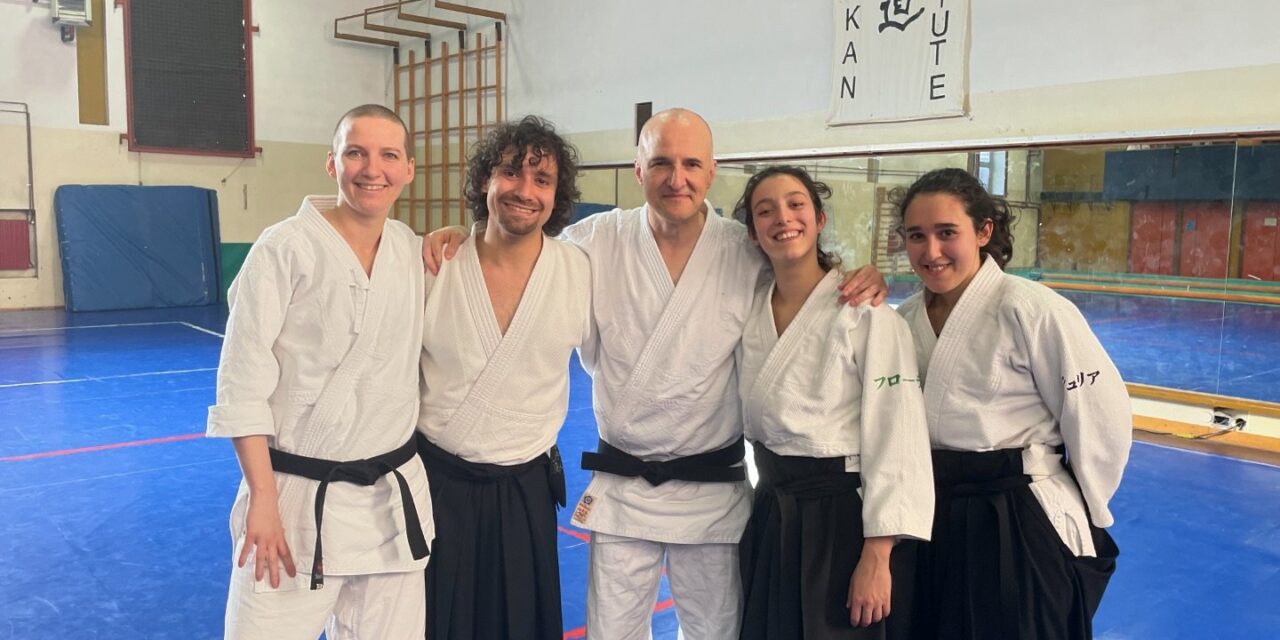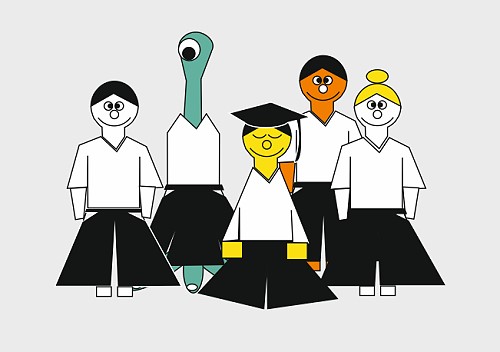Text translated properly by Elisa Meloni.
On Saturday, April 6th, taking advantage of the break from university, we set off for Bologna for a seminar with Bodo Rödel, VI Dan, student of Christian Tissier Shihan. He is the teaching director of the Aikido Schule Köln and a renowned German technician.
There were me, Giulia and Flora from the Pistoia dojo: we left not too late in the morning to indulge in a tour of the downtown area and a leisurely lunch before the internship.
We then set out for the dojo, where we met Bodo with Eniko, his girlfriend.
We decided to treat ourselves by going to a café so as to eat something together and chat in English. The minutes passed pleasantly and hence the time at which the gymnasium would be open arrived quickly. We made our way to the seminar site at a walking pace, but ready to begin.
I was quite excited since I had not been seeing Bodo on the tatami since the Berlin seminar in November 2023. Unfortunately I had not been able to practice with him on that occasion.
As always happens to me when I deal with such important aikidokas on the tatami, I looked forward to this experience with anticipation. As a matter of fact, I would often see videos of more experienced martial artists when I was still kyu grade. That time I was on the tatami with one of those very aikidokas, ready to put his teaching into practice.
Eniko’s father, Miklos, who has been living in the region since a year and a half, welcomed us. Afterwards, we payed the charge and, keigogi on, we stepped onto the tatami.
The gym was large with a tatami arranged in the shape of L, which I found unusual yet creative. Sometimes, as least as far as gyms are concerned, practicality matters much more that aesthetics.
There were not many of us, but it is well known that the number of practitioners is inversely proportional to the time a teacher can dedicate to singular or small-group explanations. Therefore, we believed it was positive since the teacher could give special attention to everyone.
Right away, Bodo surprised me by tackling Irimi tenkan. As trivial as this may sound, it had been quite the opposite because of the recent rediscovery of uke. It has indeed been under the thumb of movements conjured up by the vices of Aikido. Nonetheless, a plethora of aikidokas continue this role play without really understanding the correct attitude to take and the real purpose of what is being done. The movements, which are and must be constructed, are however usually taken to the level of the harmless attacker, without any critical approach to oneself.
(Disclaimer: we are not talking about real/street/violent attack and/or implementation, just the mindset one should have)
– Small digression: I guess I can feel lucky considering that the last seminars I organized and participated in were, one way or another, centered on the following aspect. Nino Dellisanti’s seminar emphasized the concept in the use of bokken and jo, while Francesco Dessì and Alessio Autuori focused on the concepts of a reactive uke. Such a characteristic results from the brevity and the timing of the technique to apply. Thanks are also due to them, being the main technicians responsible for my training (besides Michele Mazzi. whom I thank and will always thank for introducing me to this technical line of Aikido). –
Seminar tip: the uke follows, then attacks in an almost persecutory way by putting pressure with the contact. He is not a brute, but neither is he a rag doll. He is (tries to be) measured, calm in his intention, determined and clear in his attitude. The work continued on a traditional basis: a Katate Dori was added, tori and uke applied the aforementioned tai sabaki, which was followed by a Shiho Nage Omote after some exchanges.
The interesting part was then distance control. The two figures can choose: tori can either move away again (with body only, not with intention) or give information to the receiver by leading to the appropriate distance recovery. The work then evolved into Yokomen Uchi, developing the same projection and later on the evergreen Ikkyo. From here, the research focused on the homote forms, both internal and external. Not only was it about irimi tenkan, but also about irimi kaiten, which went from a 90° to a 45° inclination with respect to the starting position (to be clearer: a lateralized step is performed with kaiten orthogonally from the initial position). Levels of increasing difficulty were 3, going from static to reacting to the uke’s attack without locking on the position. The technique also had to be executed while closing the working angle so as to maximize the fluidity of the movement.
To conclude, the practice switched to a te awase, focusing on the uke’s behavior once again, a practice that is always enjoyable and to be practiced. From this last work 2 very beautiful forms of Kokyu Nage came, obtained precisely from the movement and “pressure” exerted by uke.
The two hours of practice flew by, and even though the work was not myriad, a more than solid foundation was laid by researching and applying the principles of practice in both parties involved. Briefly, a refined, if aesthetically essential, practice.
I found this essential to my practice.
Heartfelt thanks for the day of practice goes to Giulia and Flora for attending the seminars with me. Thanks to the organization, to all the practitioners, and most importantly, to Eniko and Bodo!
See you soon!
__
This writing is not meant to be a true account of the internship I had the pleasure of attending, but an invitation to everyone to try to improve themselves and be good ukes. They should not be victims of the role, or at least not beyond a tolerance that Our Aikido technicians are always able to provide, no matter the Aikido school they come from.










